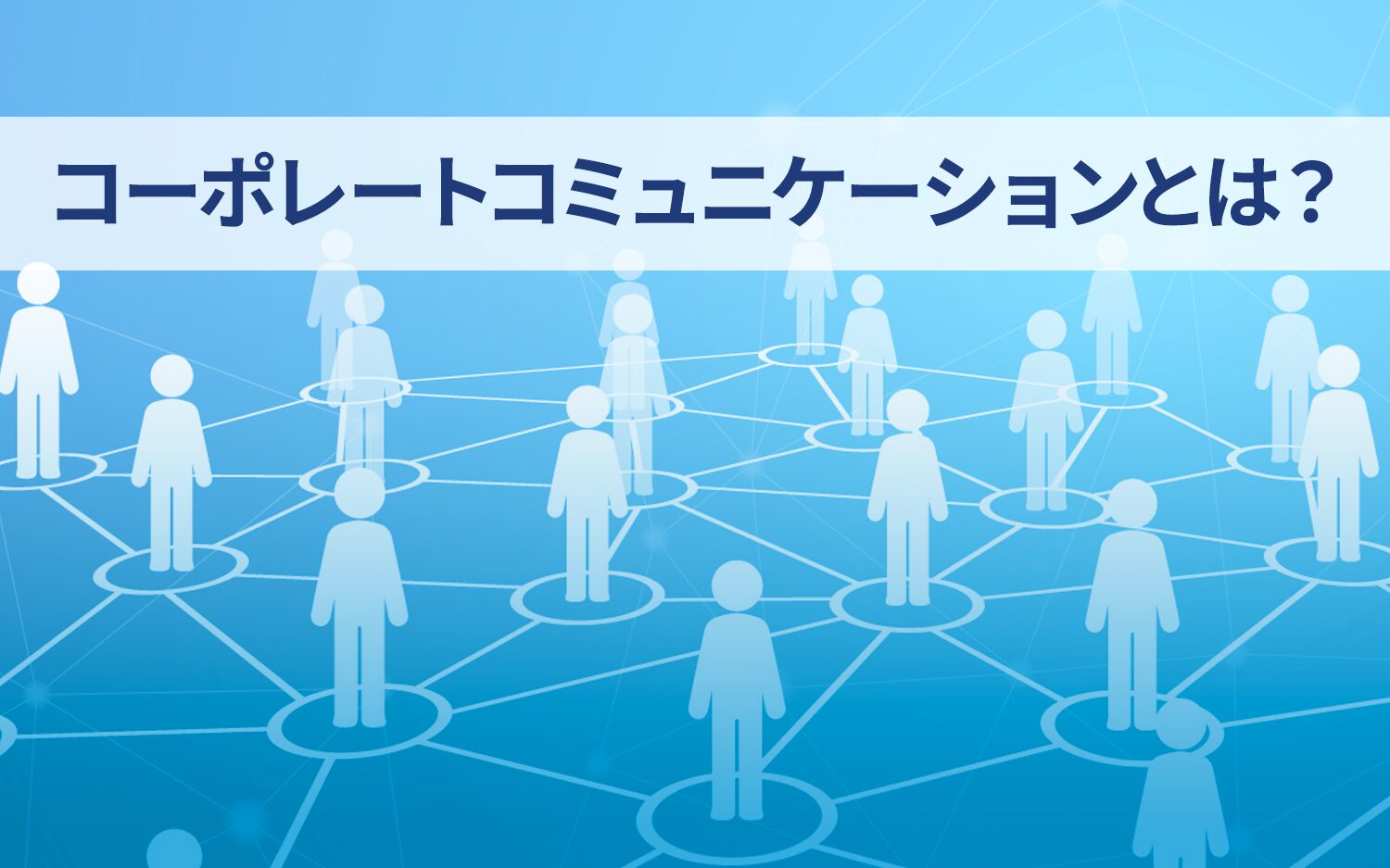Necessity of Corporate Communication and 11 Means of Corporate Communication
2025/08/21

Corporate CommunicationRefers to the strategic process of information dissemination and dialogue (communication) that companies conduct with stakeholders both inside and outside the organization, such as customers, business partners, shareholders, investors, and employees.
Its ultimate purpose is toUnderstand what society demands from the company, reflect it in corporate management, and build a foundation for sustainable growth.is to achieve this.
Typical Means of Corporate CommunicationThe following 11 methods are listed as
2. Websites and Blogs
3. Social Media
4. Internal Communication Tools
5. Events and Webinars
6. Public Relations and Advertising
7. CSR Reports
8. Customer Support and Customer Relations
9. External Reports and Annual Reports
(10) Social Listening
(11) Purpose Branding
This article will detail the necessity of corporate communication and the points to consider when practicing it.
Table of Contents
- 1 Eleven means of corporate communication
- 2 Five Reasons Why Corporate Communication is Needed
- 3 Five Practical Examples of Corporate Communication
- 3.1 Example 1: Panasonic - Strengthening B2B Communication
- 3.2 Example 2: Nissan - Rebuilding Trust After the Ghosn Shock
- 3.3 Example 3: Apple - Branding through Product Launch Events
- 3.4 Example 4: LEGO - Co-creating Products with Customers
- 3.5 Case Study 5: Unilever: Strengthening Purpose-Driven Brands
- 4 Three Points to Consider in Corporate Communication
- 5 Conclusion
Eleven means of corporate communication
Corporate communication has various means to effectively convey information to stakeholders both inside and outside the company.11 main measuresare summarized below.
| Means | Purpose | Features |
| 1. Press Releases | Communicate new product launches, significant company trends, and financial results to the media. | By officially releasing information, it is widely disseminated through the media. |
| 2. Websites and Blogs | Utilized as a platform to thoroughly explain company information, services, and products. | Builds the company's worldview and brand image, providing in-depth information to customers and investors. Blogs can also be used to share more expert knowledge and industry trends. |
| 3. Social Media | Facilitates two-way communication with customers and stakeholders. Shares the latest company news, campaigns, and events. | Allows for real-time dialogue. Capable of reaching a wide audience and easily building a company’s personality through videos and images. |
| 4. Internal Communication Tools | Promotes information sharing among employees, communication of corporate policies, and team building. | Utilizes emails, intranets, internal newsletters, or communication tools such as Slack and Chatwork. |
| 5. Events and Webinars | Deepens dialogue with stakeholders through new product launches, industry seminars, and conferences. | Provides opportunities for direct dialogue, enhancing brand credibility and fostering future sustained relationships. |
| 6. Public Relations and Advertising | Enhances awareness of products, services, or the company itself, stimulating consumer purchasing motivation and building a positive corporate image. | Often recognized as a reliable source of information. Building good relationships with media personnel is essential. |
| 7. CSR Reports | Communicates the company's commitment to social responsibility (CSR) and sustainability to stakeholders. | Enhances the company’s social credibility through transparent information provision. |
| 8. Customer Support and Customer Relations | Builds relationships with customers and fosters long-term loyalty. | Communicates with customers through chat, phone, and email, providing quick and effective support to establish good trust relationships. |
| 9. External Reports and Annual Reports | Reports the company’s annual performance and activities to a wide range of stakeholders, including investors and shareholders. | An important resource for strengthening corporate credibility and ensuring transparency. |
| (10) Social Listening | Consumer feedback posted on social networking sites and bulletin boards is picked up and reflected in policies and product improvements. | In contrast to conventional one-way information dissemination, interactive communication can be realized by analyzing and utilizing consumers' opinions. |
| (11) Purpose Branding | Clearly articulate the company's raison d'etre (purpose) and social values to gain sympathy and trust. | This is appropriate in an age when consumers are choosing brands based on their values. |
By appropriately combining these means, companies can effectively disseminate information to employees and diverse stakeholders,build and maintain a strong brand and trust.This can be achieved.
Five Reasons Why Corporate Communication is Needed
In the era when mass media such as television, radio, and newspapers were mainstream, the information available to consumers was one-sided, and the options for products and services were limited. However, the advent of the internet age has resulted in a world overflowing with information and products, giving consumers many choices.
The era where products and services could sell themselves is over,and companies now need to make continuous efforts to be chosen by consumers among the numerous options available.In this context,Corporate communication is being emphasized as part of management efforts.
there are three specific reasons why corporate communication is necessary for modern companies.
Reason 1: Differentiation from competitors.
In today's world, where the amount of information has increased due to the advancement of the internet and many companies can enter the market, the business environment has become extremely competitive. For companies to enhance their competitiveness in this environment, it is essential to go beyond mere information transmission andclearly communicate their uniqueness and values, allowing customers and stakeholders to recognize them as a 'special entity' distinct from other companies.This has become crucial.
Consequently, companies are expected not only to enhance the quality of their products and services but also to improve their overall brand image and communication abilities.
Reason 2: Rapid dissemination of information due to digitalization.
With the proliferation of the internet, especially social media, information spreads instantly, and it is not uncommon for a company's reputation to fluctuate significantly in a short period. Therefore,companies must communicate effectively in real-time.To provide rapid and accurate information dissemination, strong corporate communication is essential.
Additionally, social media serves as an effective corporate communication tool for building good trust relationships with customers.
Reason 3: Complexity of Stakeholder Relationships
Companies maintain relationships with various stakeholders including customers, investors, shareholders, communities, and government agencies. Each stakeholder has different expectations and demands, necessitating effective communication strategies to respond adequately.
Corporate communication manages these relationships andensures effective information dissemination through channels that frequently interact with each stakeholderthereby enabling the establishment of strong trust relationships.
Reason 4: Diversity of Employees and Engagement
In today's diverse workplaces, it is common for employees with different backgrounds and values to work together. Moreover, larger companies have various working locations and positions, including headquarters, branches, and remote work. Corporate communication is essential for enhancingengagement among diverse employees and fostering a sense of unity..
Reason 5: Increasing Expectations for CSR
The entire society expects companies not only to provide products and services, but also tofulfill their responsibilities regarding environmental and social issues.This expectation has become prevalent. When companies engage in social contributions, namely CSR activities, effectively communicating these efforts is crucial to garnering support from stakeholders. Corporate communication aids in effectively conveying CSR initiatives and gaining social trust.
For more details about CSR, please refer to another article.Topics that are closely related to corporate communication.Therefore, please be sure to review this article alongside that one.
Related Articles:Benefits and Case Studies of CSR that Create Corporate Social Value
For these five reasons, the necessity of corporate communication has significantly increased for modern businesses. So, what methods are available for implementing corporate communication? We will explain in the next section.
Five Practical Examples of Corporate Communication
Here are five examples of corporate communications that companies have implemented.
Example 1: Panasonic - Strengthening B2B Communication
The Panasonic Group is strengthening corporate communication in the B2B sector and deepening relationships with business partners. In particular,Through exhibitions, conferences, and websites, companies effectively convey their technological capabilities and solutions, building inter-company trust while expanding business opportunities and maintaining competitiveness.。
In addition,they have made their internal newsletter previously published for employees available on the internet,thereby renewing it to allow customers and business partners to freely access it. This has enabled them to provide a deeper understanding of their activities and foster more proactive communication with those interested.
Example 2: Nissan - Rebuilding Trust After the Ghosn Shock
Nissan Motor Company emphasized transparency in internal and external communications to rebuild corporate credibility following the arrest of former Chairman Carlos Ghosn. The management conductedregular briefings for stakeholders and also strengthened open communication within the company.They worked hard to restore trust both inside and outside the company.
In this way,it is especially essential to communicate information swiftly and transparently during challenging times.This leads to the early restoration of trust both inside and outside the organization. Continuous communication with employees, in particular, reinforces organizational cohesion and supports efforts toward reconstruction.
Example 3: Apple - Branding through Product Launch Events
Apple's regularly held product launch events serve as a quintessential success story in corporate communication through events. Their events go beyond merely announcing new products tobecoming important platforms that emphasize Apple's brand value.It has been established.
Apple's events are characterized bysimple and sophisticated presentations along with visually strong messages, consistently maintaining a coherent worldview.This strategy has successfully instilled a strong brand image in consumers and expanded the fan base.
◆Apple Product Launch Events

Source:Nihon Keizai Shimbun
Example 4: LEGO - Co-creating Products with Customers
LEGO offers a service called ‘LEGO IDEAS’ where fans create innovative projects based on the concept of ‘the LEGO they want’ and determine productization through voting.‘LEGO IDEAS’This service was launched in 2014 and
has successfully created deep engagement with customers through this service.By providing a platform for customers to directly engage with the brand, it increases customer loyalty and differentiates itself from competitors.Providing a mechanism for customers to engage directly with the brand enhances customer loyalty and contributes to differentiation from competitors.
Reference: LEGO® Ideas (Official Online Store)
Case Study 5: Unilever: Strengthening Purpose-Driven Brands
Since the 2010s, Unilever has been working to "put sustainability at the heart of our business," and in particularThe company positions brands such as "Dove" and "Ben & Jerry's" as Purpose-driven brands.
These brands symbolize both "solving social issues" and "business growth," and in fact, according to the company's official announcementPurpose-led Brands have, on average, higher growth rates than other brands."It is said.
Reference: Unilever Japan official website
Thus, effective corporate communication can enhance a company’s competitiveness in various ways, includingstrengthening brand, building deep relationships with customers, social contributions, or risk hedging during crises.This is the strategy of corporate communication.
However, there are essential considerations to keep in mind when putting these strategies into practice. We will explain this in the next section.
Three Points to Consider in Corporate Communication
Corporate communication is,in some cases, subject to unintended misunderstandings, loss of trust, and even adverse effects on the company's reputation.Therefore, it is important to take the following points into consideration while practicing corporate communication.
Here, we will discuss three particularly important points in corporate communication.Three Key Considerationswill be explained.
Point 1: Maintain Consistency
Consistency is extremely important in corporate communication becauseinconsistent messages communicated internally and externally can lead to confusion, ultimately undermining credibility.This can lead to severe consequences. Particularly,when information is transmitted using several channels, maintaining message alignment is crucial.It’s essential to keep this in mind.
In advance,creating guidelines for message unification can help prevent inconsistencies in corporate behavior and communication.By doing so, consistency in company behavior and information dissemination will be more easily maintained.
Point 2: Ensure speed and transparency.
Hiding information excessively or providing inaccurate information can significantly damage a company’s trust. Especially incrisis situations or when issues arise, rapid and transparent responses from the company are required.Thus, it is important to strive to provide accurate and transparent information as quickly as possible.
In particular, even in emergencies or when facing bad news,swiftly communicate the situation without concealing informationcan help establish long-term trust relationships.
Point 3: Understand Your Communication Target
Ignoring the needs and concerns of the customers or stakeholders being communicated to will result in messages not achieving their desired effect. For instance, the communication tailored to employees requires a different approach than that directed at investors. Therefore,it is essential to precisely define the target and select the most appropriate messages and channels for each.This is crucial.
Additionally, in the case of global companies,if the same message is communicated to people with different cultures and languages, it can lead to misunderstandings or resentment.Ignoring cultural differences can have adverse effects, so it's necessary to consider cultural backgrounds and choose communication styles and content that suit them.
Conclusion
For businesses in today's complex society, characterized by accelerated information transmission, intensified corporate competition, and diversified working styles,corporate communication is one of the most crucial management strategies.Its importance is likely to continue growing in the future.
The means and targets of corporate communication are diverse, and their execution and management are not straightforward. However, by actively practicing while considering the points highlighted in this article, companies can obtain strong brand value and competitiveness.
Communication is not one-directional but rather two-way. If you find yourself wondering, 'What should I do?',start by listening to the voices of customers, business partners, and employees.Let’s begin there.
-
Contact Us
-
Request Info
-
Free Trial
-
Partner System







